How Chicago Laid the Foundation for High-Tech Architecture
It’s been one year since JMC Steel Group headquarters moved to Chicago and we’re proud to call the Windy City home. While it’s known for deep-dish pizza, blues music and the Super Bowl shuffle, we’re most proud of Chicago’s steel skyline and its use of hollow structural sections (HSS). Today, I want to provide you a little background on Chicago’s history of architecturally exposed structural steel and why it continues to be the material of choice for designers and owners.

A Brief History
Following World War II, the Second Chicago School of architecture emerged. Deeply connected with High Tech architecture, this style highlights a structure’s skeletal steel frame. Historian Reyner Banham referred to early High Tech structures as “serviced sheds,” due to their exposure of mechanical services in addition to the structure. [Source]
This adoption of exposed structural steel and the increased availability of HSS allowed for forward-looking architecture. It was believed that using steel meant progress through industrial technology, because with steel, designers were able to control their environment rather than adapt to it. Designers wanted buildings to be functional and efficient, not artistic or symbolic. Structures were deemed as “honest” in their use of materials and structural forms. [Source]
 The Second Chicago School, introduced by Ludwig Mies van der Rohe and passed on by architectural and engineering firms such as Loeble Schlossman Hackle, Skidmore Owings Merrill (SOM), the early work of Murphy-Jahn, and others, redefined high-rise building design by emphasizing factory-produced materials, such as steel, that were cheap, simple and functional. In conjunction with structural reliability, Frazlur Khan designed new structural solutions for tall buildings, thus creating the iconic steel structures filling our skylines today. His two internationally famous designs, the John Hancock Center and the Willis Tower, demonstrate two different and innovative concepts of structural forms – a braced tube system (Hancock) and a cellular bundled tube system (Willis). [Source]
The Second Chicago School, introduced by Ludwig Mies van der Rohe and passed on by architectural and engineering firms such as Loeble Schlossman Hackle, Skidmore Owings Merrill (SOM), the early work of Murphy-Jahn, and others, redefined high-rise building design by emphasizing factory-produced materials, such as steel, that were cheap, simple and functional. In conjunction with structural reliability, Frazlur Khan designed new structural solutions for tall buildings, thus creating the iconic steel structures filling our skylines today. His two internationally famous designs, the John Hancock Center and the Willis Tower, demonstrate two different and innovative concepts of structural forms – a braced tube system (Hancock) and a cellular bundled tube system (Willis). [Source]
The first building to apply the tube-frame construction was theDeWitt-Chestnut Apartment Building,which Khan designed and was completed inChicagoby 1963. Fazlur Khan defined theHSS structureas “a three dimensional space structure composed of three, four or possibly more frames, braced frames, or shear walls, joined at or near their edges to form a vertical tube-like structural system capable of resisting lateral forces in any direction by cantilevering from the foundation.” [Source]
The Material of Choice
Steel is a statement piece—a material that empowers a designer’s architectural vision. The bold presence of HSS and its shape becomes a visually engaging part of a building or other structure. For over 60 years, structural steel tube has allowed designers to meet the challenges of modern architecture and design the type of structures that break new aesthetic ground and enrich the public landscape.
While exposed structural steel tube was once the choice of a few noteworthy projects, architects today are increasingly recognizing its benefits in their design of skyscrapers, bridges, stadiums and other structures. Because High Tech architecture exaggerates the technical function of a building, it is no surprise steel remains a superior material.
Choosing HSS opens up enormous design possibilities that aren’t available when using other sections or materials. The giant black, glass boxes that we so often see in Chicago and other cities are often taken for granted and seen as mass-produced monstrosities. Yet, if one really looks closely and takes in the aura of the buildings, their beauty can be appreciated. They are strong. They are solid. They are simple, yet incredibly complex. They are bold, yet elegant. [Source]
To put it in the words of one of Mies’ famous expressions: Less is more.
Examples of High Tech architecture in Chicago

Sears Tower (Willis Tower)
(1970—1974)
Skidmore, Owings & Merrill, SOM
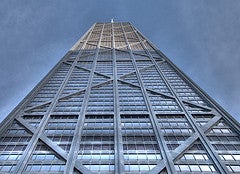
John Hancock Center
(1967—1970)
Skidmore, Owings & Merrill, SOM
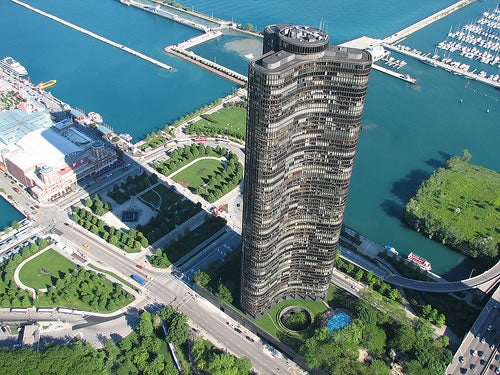
Lake Point Tower
(1965—1968)
Schipporeit & Heinrich
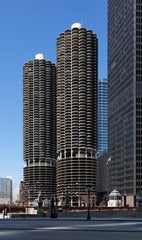
Marina City
(1959—1964)
Bertrand Goldberg
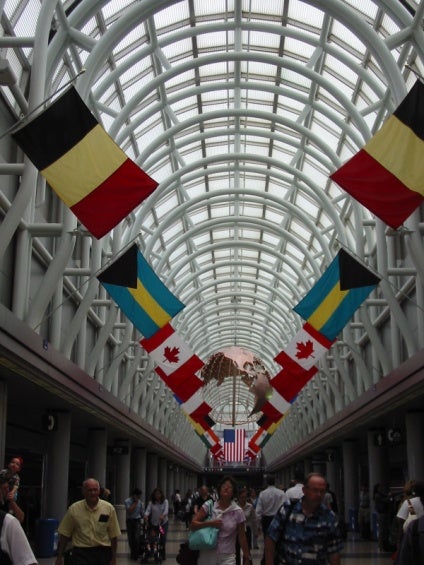
O’Hare International Airport, United Airlines Terminal 1
1985-1988)
Helmut Jahn
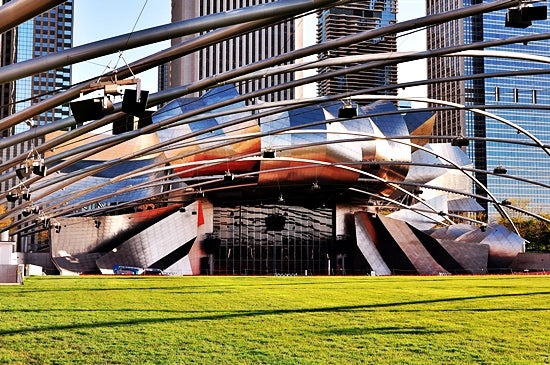
Jay Pritzker Pavilion
(1999-2004)
Frank Gehry
